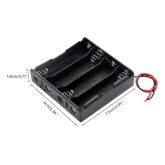Greetings Solar adventurers,
I was wondering If you could help me understand battery life in relation with the specifications with a type of 18650 batteries I have.
In the specifications sheet, this is found:

Standard Discharge Current
My understanding is that for an optimal battery life (amount of cycles) and nominal capacity perception a current no higher than 0,5 A can be drained. Whenever a higher current is drained, then the battery capacity perceived is lower and the battery can be slightly damaged over time. The batteries can however provide higher currents than that.
Max. Discharge Current
This is the maximal current a battery can provide without overheating. Over this current the battery overheats which leads to quick damage and a significantly lower capacity compared to nominal capacity. However, peak current might still be possible (1-2s) when switching on appliances.
Given the fact that I do not have many 18650 cells and therefore I need to drain more than 0,5 A from each cell to reach a decent power output. Which current would you recommend me to use as limit for continuous usage of home appliances; where (1) no significant damage will be caused to the cells and (2) no significant decrease on the batteries capacity will occur.
Do you have any experiencing on damaging 18650 cells due to draining more than the standard discharge current?
Can you please share your experiences?
Thank you!
I was wondering If you could help me understand battery life in relation with the specifications with a type of 18650 batteries I have.
In the specifications sheet, this is found:

Standard Discharge Current
My understanding is that for an optimal battery life (amount of cycles) and nominal capacity perception a current no higher than 0,5 A can be drained. Whenever a higher current is drained, then the battery capacity perceived is lower and the battery can be slightly damaged over time. The batteries can however provide higher currents than that.
Max. Discharge Current
This is the maximal current a battery can provide without overheating. Over this current the battery overheats which leads to quick damage and a significantly lower capacity compared to nominal capacity. However, peak current might still be possible (1-2s) when switching on appliances.
Given the fact that I do not have many 18650 cells and therefore I need to drain more than 0,5 A from each cell to reach a decent power output. Which current would you recommend me to use as limit for continuous usage of home appliances; where (1) no significant damage will be caused to the cells and (2) no significant decrease on the batteries capacity will occur.
Do you have any experiencing on damaging 18650 cells due to draining more than the standard discharge current?
Can you please share your experiences?
Thank you!
Last edited:



